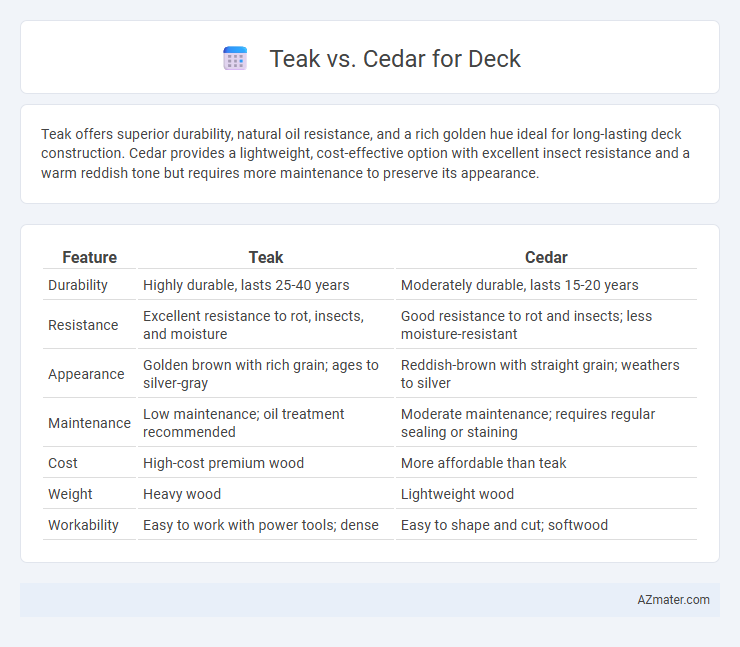Teak offers superior durability, natural oil resistance, and a rich golden hue ideal for long-lasting deck construction. Cedar provides a lightweight, cost-effective option with excellent insect resistance and a warm reddish tone but requires more maintenance to preserve its appearance.
Table of Comparison
| Feature | Teak | Cedar |
|---|---|---|
| Durability | Highly durable, lasts 25-40 years | Moderately durable, lasts 15-20 years |
| Resistance | Excellent resistance to rot, insects, and moisture | Good resistance to rot and insects; less moisture-resistant |
| Appearance | Golden brown with rich grain; ages to silver-gray | Reddish-brown with straight grain; weathers to silver |
| Maintenance | Low maintenance; oil treatment recommended | Moderate maintenance; requires regular sealing or staining |
| Cost | High-cost premium wood | More affordable than teak |
| Weight | Heavy wood | Lightweight wood |
| Workability | Easy to work with power tools; dense | Easy to shape and cut; softwood |
Introduction: Why Compare Teak and Cedar for Decks?
Teak and cedar are popular choices for decking due to their natural durability and aesthetic appeal. Teak offers exceptional resistance to moisture, decay, and insect damage, making it ideal for long-lasting outdoor use. Cedar provides a lightweight, cost-effective option with natural oils that help repel rot and insects while offering a warm, rustic appearance.
Appearance: Color, Grain, and Aesthetics
Teak offers a rich, golden-brown color that deepens with age, showcasing a smooth, straight grain that exudes luxury and warmth for deck aesthetics. Cedar presents a lighter, reddish hue with a distinctive, aromatic scent and a fine, uniform grain that adds a natural, rustic charm to outdoor spaces. Both woods age gracefully, but teak's oily texture provides a sleek, polished look while cedar's soft texture and color variations contribute to a cozy, inviting deck appearance.
Durability and Lifespan Comparison
Teak wood offers superior durability due to its natural oils, making it highly resistant to rot, insects, and weathering, with a lifespan exceeding 50 years when properly maintained. Cedar is also durable and naturally resistant to decay and insects but typically lasts 15-30 years, requiring more frequent upkeep to prevent weather damage. The dense grain of teak provides longer-lasting structural integrity, making it a premium choice for decks exposed to harsh outdoor conditions.
Resistance to Weather, Rot, and Insects
Teak wood is highly resistant to weather, rot, and insects due to its dense natural oils and tight grain, making it a superior choice for durable decks exposed to harsh outdoor conditions. Cedar, while also naturally resistant to decay and insect damage, is softer and less dense than teak, requiring regular maintenance and treatment to sustain its protective qualities. For long-lasting decking with minimal upkeep, teak outperforms cedar in resisting moisture, UV damage, and pest infestations.
Maintenance Requirements for Teak and Cedar
Teak decks demand minimal maintenance due to natural oils that resist moisture, insects, and decay, requiring only occasional cleaning and periodic oiling to preserve their golden hue. Cedar decks need more frequent upkeep, including annual sealing or staining to prevent weathering, cracking, and insect damage, as bare cedar can turn gray over time without protection. Both woods benefit from routine cleaning, but teak's dense grain and natural oils significantly reduce maintenance efforts compared to cedar.
Environmental Impact and Sustainability
Teak decks are prized for their durability and natural resistance to pests, reducing the need for chemical treatments and contributing to a lower environmental footprint over time. Cedar is a renewable resource that grows faster than teak, making it a more sustainable choice, but it requires more frequent maintenance and protective coatings, which can increase environmental impact. Both woods are best sourced from certified sustainable forests, such as FSC-certified suppliers, to ensure minimal ecological disruption and support responsible forestry practices.
Cost Analysis: Upfront and Long-Term Expenses
Teak decking has a higher upfront cost, typically ranging from $25 to $45 per square foot, due to its durability and natural oils that resist decay and insects. Cedar is more affordable initially, costing between $15 to $25 per square foot, but requires more frequent maintenance and sealing, increasing long-term expenses. Long-term, teak's lower maintenance needs can balance or exceed initial savings compared to cedar's ongoing treatment and potential replacement costs.
Installation Considerations and Workability
Teak offers superior durability and natural oils that resist decay, making it easier to work with hand and power tools during deck installation, though its density requires pre-drilled holes for fasteners. Cedar is lighter and softer, allowing faster cutting and shaping but may require more maintenance and protective coatings to prevent weathering after installation. Both woods benefit from proper acclimatization to reduce warping and ensure a smooth, long-lasting deck structure.
Slip Resistance and Comfort Underfoot
Teak offers superior slip resistance on decks due to its natural oils and dense grain structure, making it safer for wet conditions. Cedar, while softer and warmer underfoot, has lower slip resistance because of its more porous surface and tendency to absorb moisture. Choosing teak enhances deck safety and comfort in slippery environments, whereas cedar provides a cushioned feel but requires more maintenance to prevent slips.
Final Verdict: Which Wood is Best for Your Deck?
Teak offers unparalleled durability, natural resistance to moisture, and rich, warm tones that age gracefully, making it ideal for high-end decks exposed to harsh weather. Cedar is more affordable and lightweight, with good resistance to decay and insect damage, suited for moderate climates and budget-conscious projects. For a deck combining longevity, low maintenance, and premium aesthetics, teak is the best choice, while cedar suits those preferring cost-effectiveness and ease of installation.

Infographic: Teak vs Cedar for Deck
 azmater.com
azmater.com